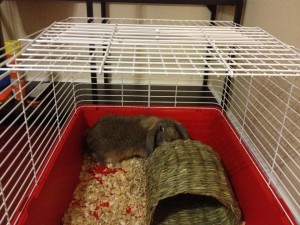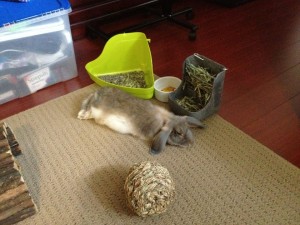A common myth about rabbits is that they stink. This assumption gives rabbits a bad reputation in the pet world. I find that this is untrue if you learn what works best and how to clean up after your pet properly.
Today I want to talk about litter training your rabbit.
I was surprised to learn that you CAN litter train your rabbit. It takes time and patience, but in the end you will not have yellow pee stains on your floor or carpet. Here are the things you will need when litter training your bunny: Patience, a litter box and litter (of course!), a watchful eye, and a bottle of white vinegar for any accidents. Rabbits are like babies: it’s not all about the cute parts, you need to make time to take care of them. Cleaning up after your bunny can be a chore, but you will be thankful when there is no smell lingering around them.
Things to Consider Before You Get to Litter Training
Types of Bedding
I got Mokona from the PJ’s Pets and they recommended I use cedar chips for the bedding and litter. Mokona always pushed the cedar chips aside in his cage so I’ve stopped using it. Also, cedar chips are light so they get kicked up as your rabbit moves around. It can be a pain to clean up after. For Mokona’s litter I use a combination of bedding and unscented recycled newspaper cat litter. NEVER use litters that clump or have a smell as they are toxic to your rabbit. Check out this article on the House Rabbit Society’s sit about Litterboxes and Liver diseases for more information on types of litters that are safe to use for your rabbit.
Space and Layout
Indoor rabbit cages can take up quite a lot of space, so it was a bit of an issue for us. We got him a corner cat litter box that would not hog his moving space or tip over when he jumped out of it. Think about how your rabbit is going to use the space and get materials that will allow them the most movement when they have to be in their cage.
It’s Litter Training Time
Your bunny has by this time pooped and pee’d in their cage. When you clean your rabbit’s cage look for where they pee most often. They usually stick to one corner of the cage, just look for wet bedding. You will be tempted to try and catch the poop, but don’t worry about that. Their poop is hard and dry so it’s pretty easy to clean up with a dustpan and brush. Once you’ve established the corner your rabbit likes to pee put the litter box there. I placed some of Mokona’s poop in the litter box that way he recognized his own smell.
Litter training Mokona was not that difficult once we established where he liked to pee. He didn’t give any problems and used the litter box without a fuss. He still had accidents every once in a while and that’s where the vinegar comes in handy. I clean his litter box every other day to reduce the smell of the urine and to make sure he’s not standing in his own pee while he does his business. Once a month I take a cloth and some vinegar to clean the litter box.
Playtime Litter Training
During exercise and play time for your rabbit pay attention to them. If they sit still, flatten their ears, and their tail goes down it’s a good sign that they are about to pee. Having multiple litter boxes goes a long way. You can have one for their cage and a second for play time. The benefit of multiple litter boxes is that they get familiar with them and will be more inclined to use it.
House Rabbit Society has a great guide on how to litter train your rabbit and other things to consider.
That’s all for now! How did you litter train your rabbit? Let me know what worked for you.

